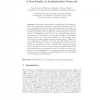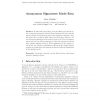31 search results - page 3 / 7 » Tightly-Secure Signatures from Chameleon Hash Functions |
ASIACRYPT
2011
Springer
12 years 4 months ago
2011
Springer
We provide constructions of (m, 1)-programmable hash functions (PHFs) for m ≥ 2. Mimicking certain programmability properties of random oracles, PHFs can, e.g., be plugged into ...
SIGOPS
1998
13 years 4 months ago
1998
Abstract. We present a related family of authentication and digital signature protocols based on symmetric cryptographic primitives which perform substantially better than previous...
FSE
2010
Springer
13 years 9 months ago
2010
Springer
We answer the question of Reyhanitabar et al. from FSE’09 of constructing a domain extension scheme for enhanced target collisionresistant (eTCR) hash functions with sublinear ke...
ACISP
2007
Springer
13 years 11 months ago
2007
Springer
Abstract. Digital signatures are often proven to be secure in the random oracle model while hash functions deviate more and more from this idealization. Liskov proposed to model a ...
PKC
2007
Springer
13 years 11 months ago
2007
Springer
Abstract. At PKC 2006, Yang, Wong, Deng and Wang proposed the notion of anonymous signature schemes where signatures do not reveal the signer’s identity, as long as some parts of...


